
Euphoria: Lights, Camera, High School
Marcell Rév, HCA provides a tutorial on his edgy approach to the adventurous HBO series.

Photos by Eddy Chen, courtesy of HBO
High school means many different things to many different people. Perhaps the only aspect that can be universally agreed upon is that it is a seminal period in a young individual’s life, the so-called “coming of age” into adulthood. Film and television have mined this experience for decades, creating an entire genre that’s often dubbed “teen drama.” Most recently, the HBO series Euphoria — starring Zendaya, as Rue, a Zoomer struggling with addition issues — takes this genre into new territory. The show endeavors to go beyond the reality of ordinary high-school life and express what it feels like to be a teenager today — in all of its epic, dramatic and brutal glory.
“We’re definitely not exploring the socioeconomic background of these people,” says cinematographer Marcell Rév, HCA, who shot the series’ pilot and multiple episodes of both seasons for showrunner Sam Levinson. “We were joking on set, because neither Zendaya, Sam nor I went to a regular American high school. But I don’t think the typical American high-school experience is the point of the show. The point is the experience of growing up — having these kinds of difficulties and how you overcome them and try to become a person. I think that’s an experience we all share.”
Raised in Hungary, Rév studied cinematography at the University of Theatre and Film Arts in Budapest. “You apply to the cinematography program, and you learn about lighting for five years,” Rév recalls. “You spend two or three days a week on a stage — lighting, doing exercises or shooting student films. It’s massive practice. And we were shooting our little thesis films on film — 16mm and 35mm, both black-and-white and color — which gave us a really good background in the format. Since it was a public university and very poor, we didn’t have ideal resources. We had only a tiny stage, not great equipment, and old film cameras. But we got to shoot on film, which was amazing. And we had good teachers.”
Rév’s old-school education prepared him well for challenging assignments like Euphoria, which would test his entire range of skills in both film and video formats. He first got wind of the series at the 2018 Sundance premiere of Assassination Nation, a movie he shot for its writer-director Levinson. At the festival, Levinson pitched Rév his next project: a television show based on a 2012 Israeli miniseries called Euphoria. “I remember Sam saying that he wanted to create a show that looks like how teenagers of Generation Z imagine themselves, instead of how they look from the outside,” he says.
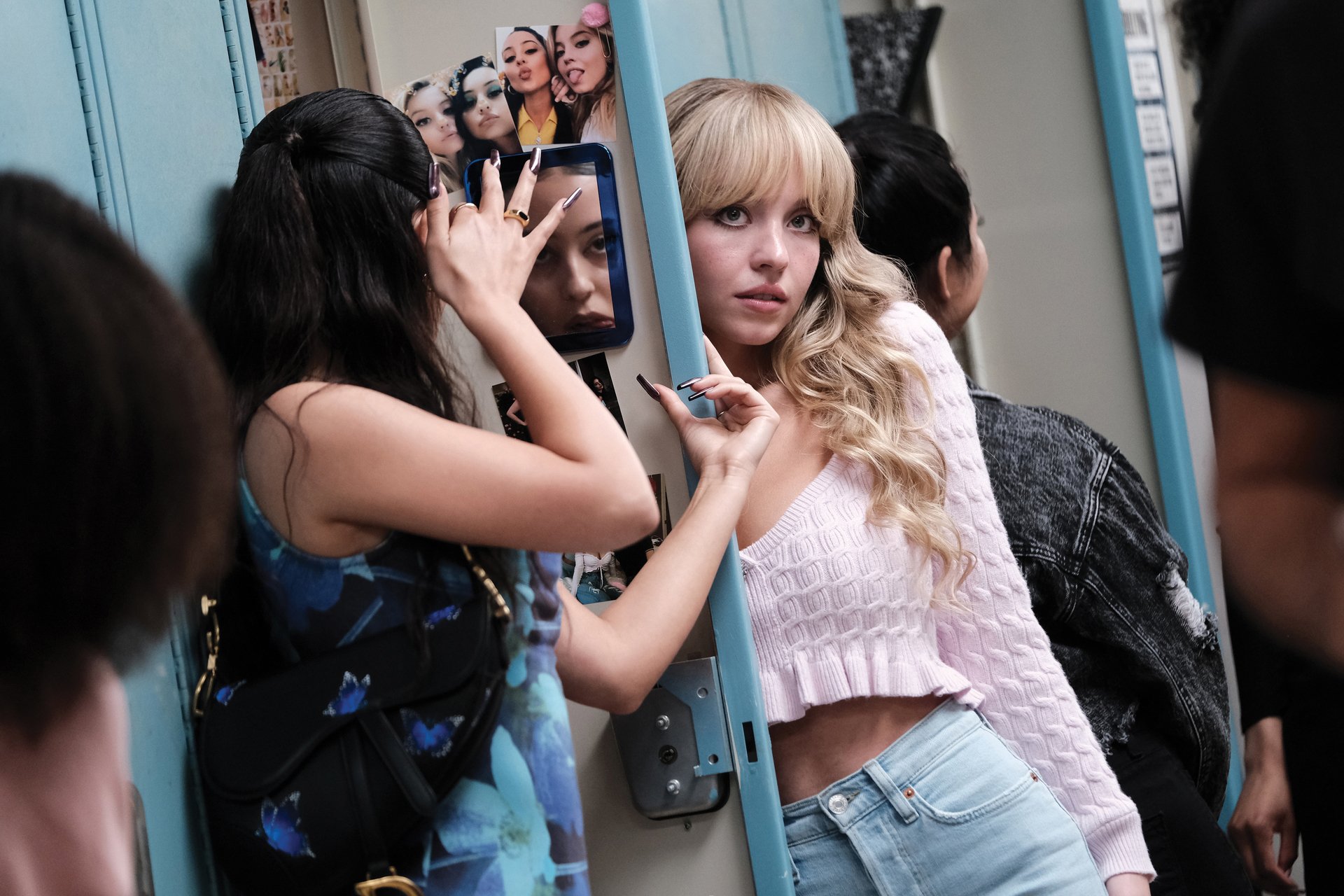
(Sydney Sweeney) have a locker confab in the high-school hallway.

Rév didn’t watch the original series when collaborating with Levinson to conceive Euphoria’s signature visual style, so to his knowledge, none of the visuals are influenced by the Israeli production. Rather, the collaborators spoke about capturing the organic energy of Paul Thomas Anderson’s 1999 psychological drama Magnolia, shot by Robert Elswit, ASC. “Magnolia ties together its storylines with camera movement so that you feel like everything is connected,” Rév says. He also turned to the still photography of Todd Hido, Joel Sternfeld and Greg Girard. “There is a loneliness to the pictures, especially in the work of Todd Hido,” he says. “They evoke the feeling of being alone in this world, and that’s very much the kind of small-town or suburban America we were trying to create — one that feels a little lonely and left alone.”
While the still images provided sparks of influence, Rév didn’t want to mimic their lighting constructions. “It’s more like we were inspired by the atmosphere in a photograph. You might take something, like a little element from an image, and use that. It helps you to get on that wave and tap into a certain kind of mood.”
For the first season, Rév and Levinson settled on what they considered a very “in-the-moment” photographic look that would employ Arri Rental’s Prime DNA lenses on the Alexa 65. The larger-format digital-cinema camera was relatively new at the time and mostly unused in television. The lenses were also atypical for television, as they produced unique image attributes. “I found this very fast T1.6 lens that had a 65mm focal length, and we basically shot 95 to 98 percent of the show on that one lens,” Rév says. “It’s equal to a 35mm lens on a Super 35mm camera — so it’s a nice size for a close-up, but if you go further back, you can do a nice wide shot at the same time. And the way the Alexa 65 sensor renders the space, you don’t need that many lenses, so your lens kit becomes smaller. This lens also had a halo effect, which took away the crispiness of digital I’m always struggling with and created a dirtier image that we really enjoyed.”

While shooting the pilot and three other episodes of Season 1, Rév tried to keep the lighting simple, as did the cinematographers who shot the show’s other episodes, Drew Daniels and Adam Newport-Berra. “We were more into colors at the time,” the cinematographer says, “and we used colored lights to keep everything on the yellow-blue color contrast — for both night and day scenes.” For day exteriors, he combined tungsten units for sunlight with ambient lights that had a daylight color. During night scenes, Rév leaned toward fluorescents or cooler HMIs for backlights, while yellow-reddish sodium streetlamps served as practical sources. “This creates a light color contrast inside the space,” he explains, “and we were trying to build on that color contrast throughout the season.”
The first season’s lighting package included a mixture of HMIs, tungsten units and LEDs. However, there’s one light Rév particularly favors: “I love a Mole-Richardson Molebeam for sunlight because it produces a shaft of light that’s like the way direct sun would come into a room,” he says. “It’s great because it feels very real.”
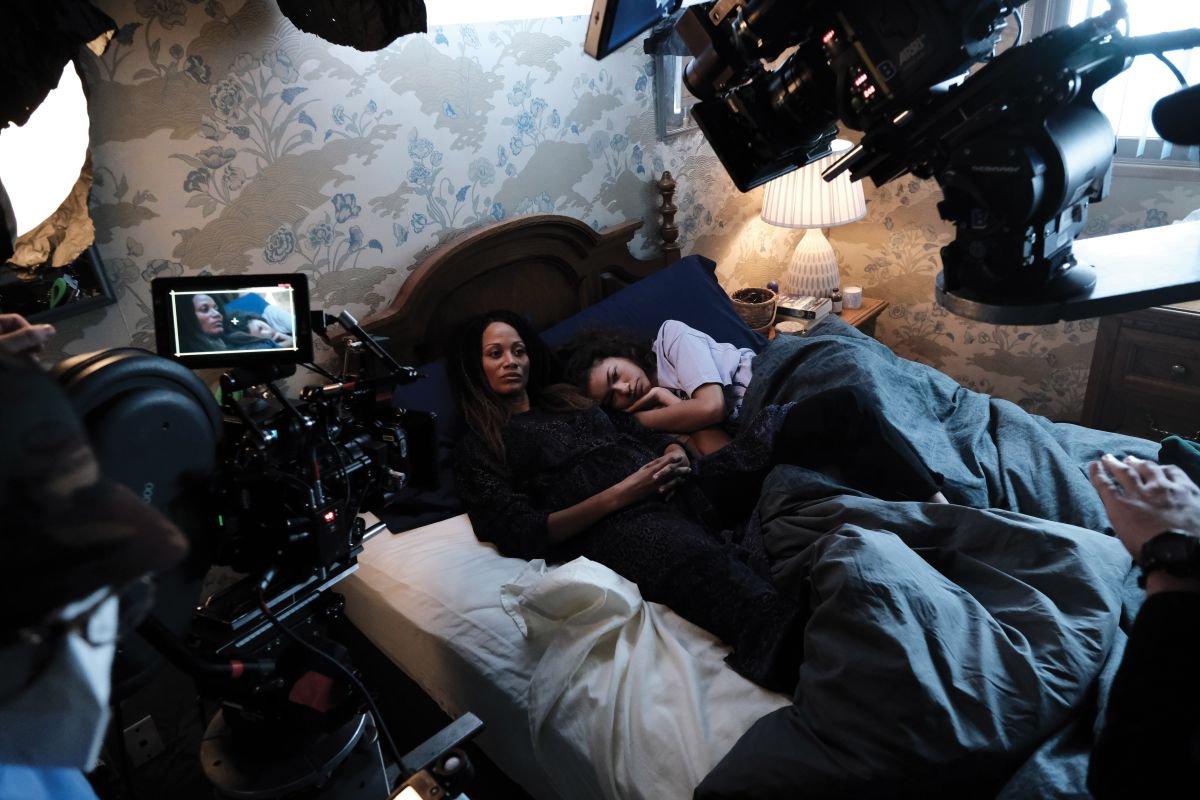
For the second season, Rév and Levinson wanted to take a different visual approach, but production was delayed due to the Covid-19 pandemic. During the break, Rév shot the feature Arri Master Primes (AC April ’21), as well as two special episodes of Euphoria that served as a bridge between the seasons, both technically and artistically. The biggest change was the switch from shooting mostly on digital video to shooting primarily on film. For these episodes, the cinematographer chose to pair the 35mm Arricam LT with Kodak Vision3 500T film stocks, although he also shot some 16mm on the Arri 416. The shift to film also necessitated a change in the lens kit, with Arri Master Primes, Kowa Cine Prominars, Cooke S4s and Zeiss Super Speeds called into service. “I was trying to gather a set of lenses that had different [characteristics] for different situations,” Rev says. “We felt that because we had found a cohesive stylistic approach that was supported by the lighting and the film stock, we could afford to vary our lenses and adapt to certain situations with our toolset.”
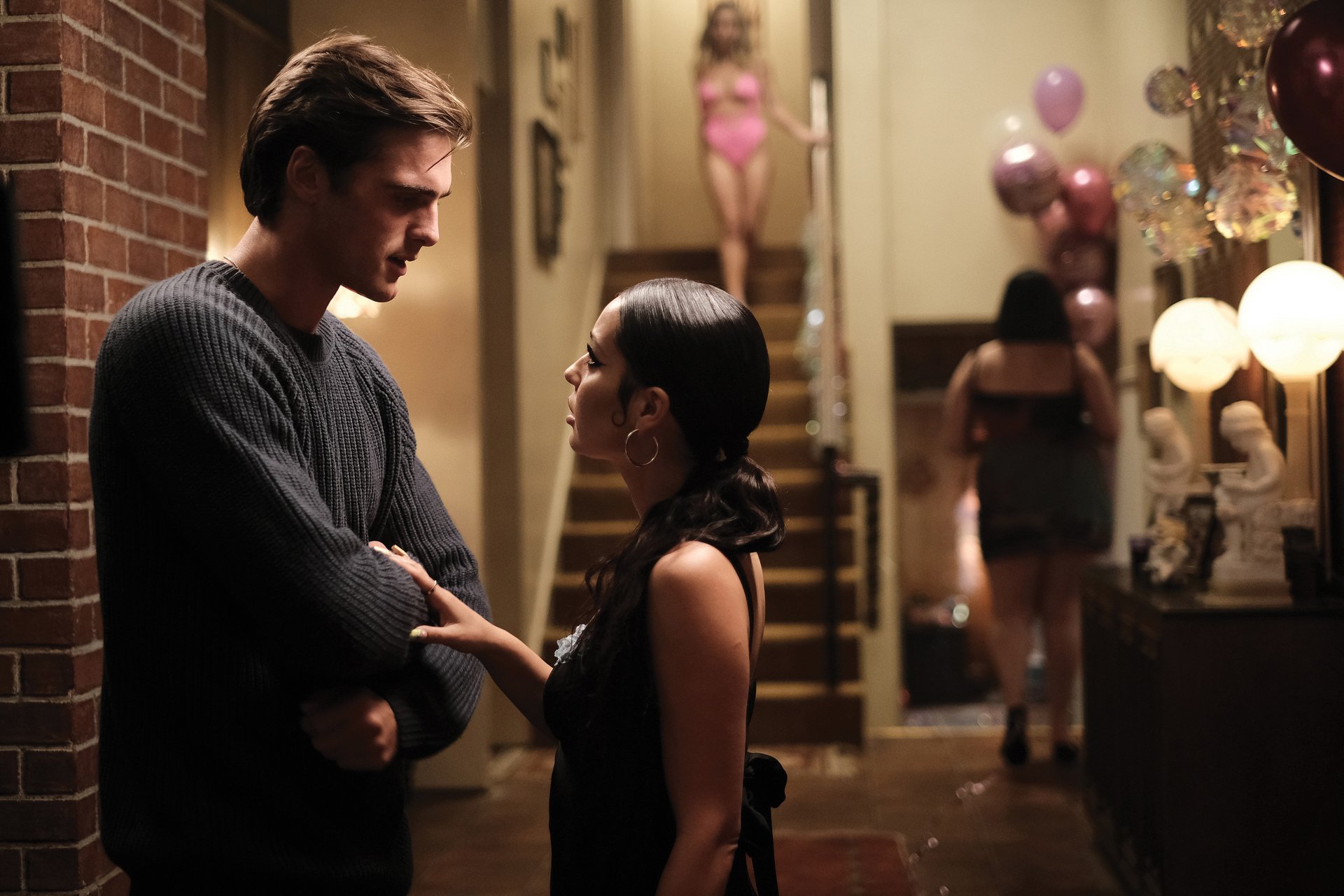
Nate (Jacob Elordi) and Maddy leads
to infidelities that cause an explosive
conflict between Maddy and Cassie.
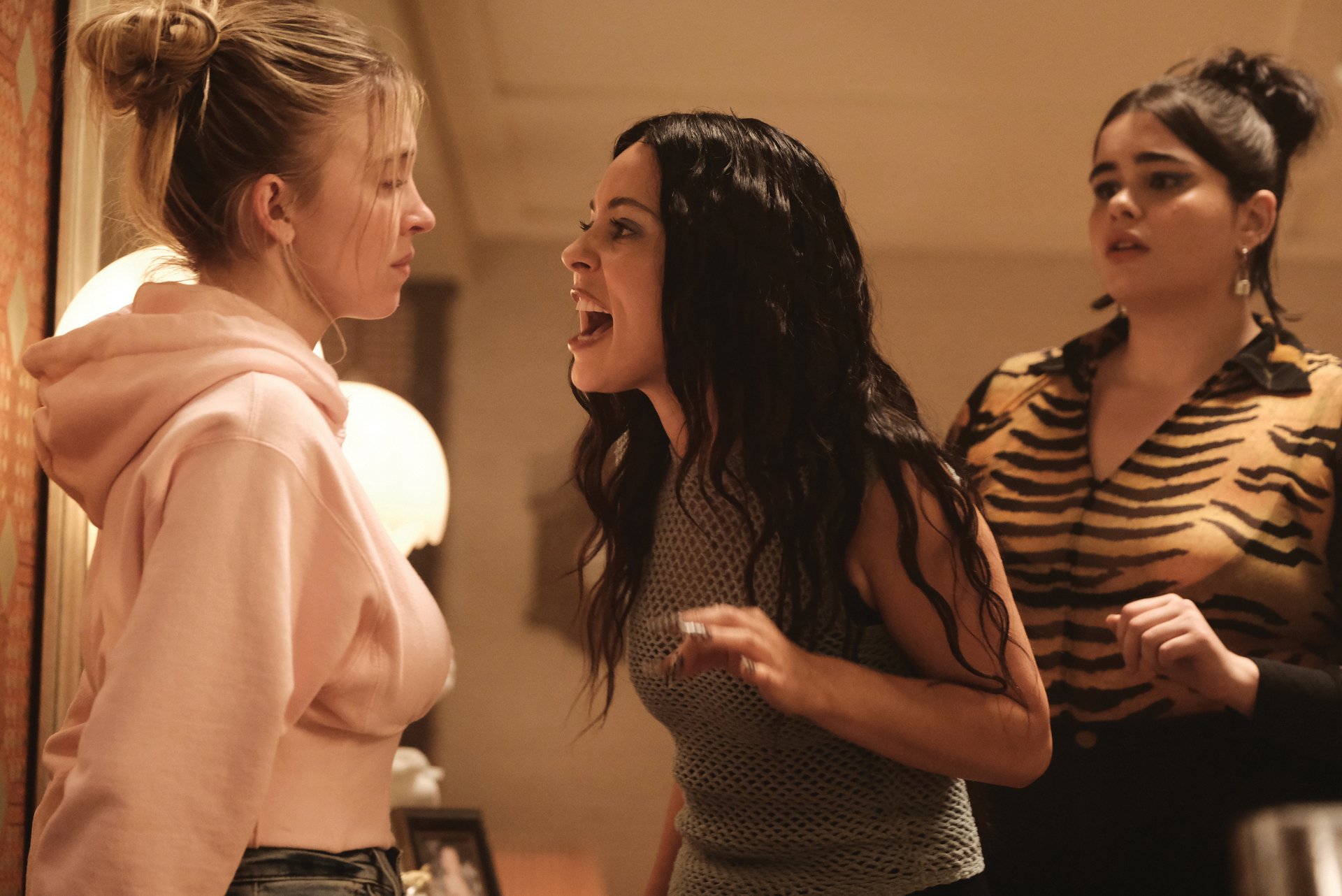
The first of the special episodes was limited to one location: a 24-hour diner where Rue and Ali (Colman Domingo) speak to each other across a table. Rév used various LED sources and HMI backlights to achieve the late-night look, manipulating them with lighting programmer Tim van der Linden. Rév notes that Rob Witt “did an amazing job” operating the B camera in the diner, and credits him with “capturing some beautiful moments.”
The episode gave Rév the creative freedom to concentrate on details. “On a normal Euphoria episode, we have like 100 to 120 scenes — some of them are vignettes, delineated as separate strips on the call sheet, and they’re mostly shot on separate locations, too. But the diner episode was just the opposite. For the most part, we were on just two close-ups, which then becomes an opportunity to dive deep and really explore a face, and manicure that one scene,” he says. “The way you choose your focal length, the way you choose your eyeline, whether you put your camera an inch to the left or the right — these small decisions suddenly become so significant. At this point, it’s all about supporting a performance. If you make those decisions right, you can really support the performance. If you don’t, you can destroy one.”
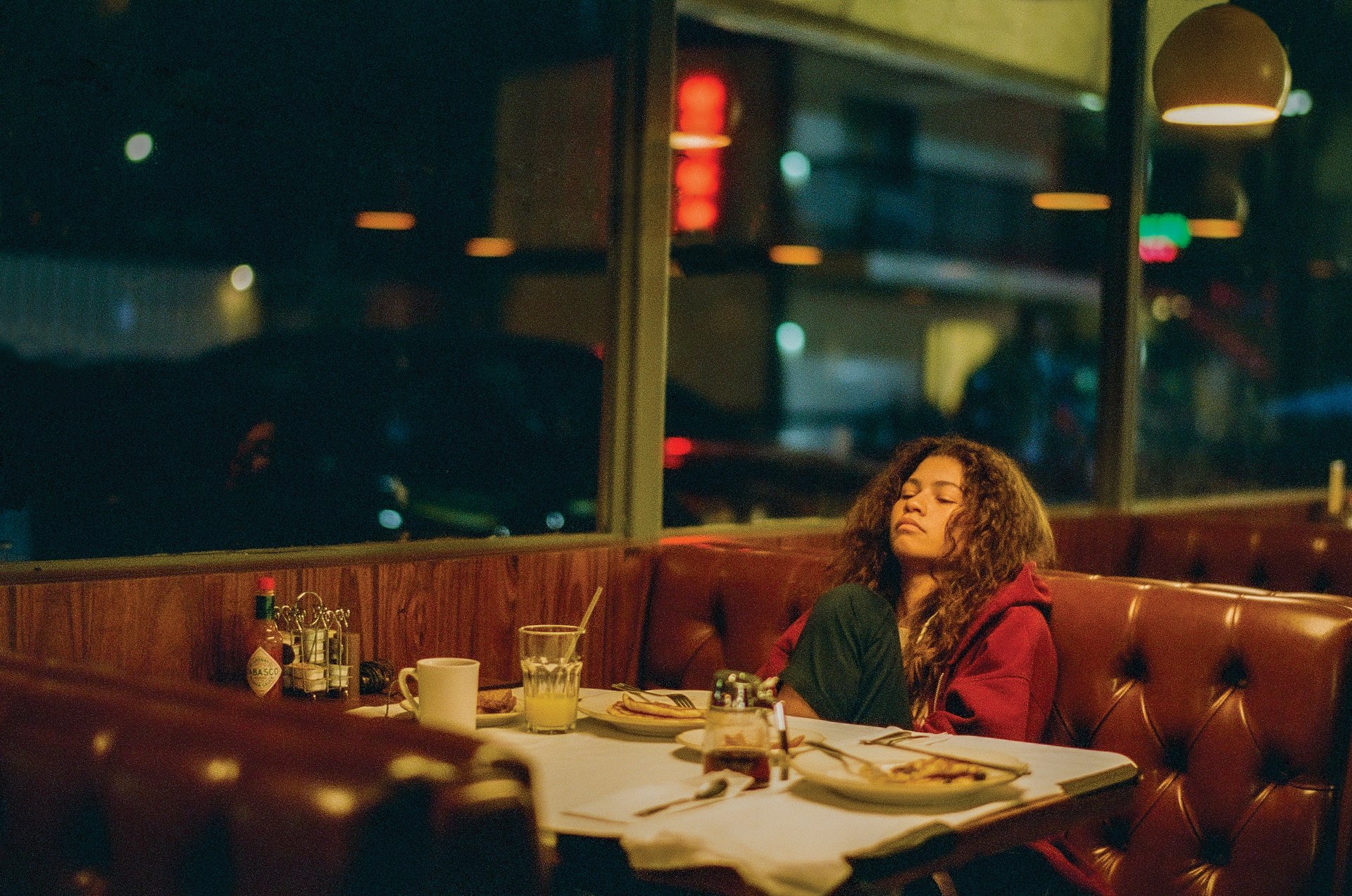
He adds, “For the diner scene we were choosing the focal length of our lenses to tap into the scene’s level of intimacy, by starting on a wide lens closer to the actors and then slowly switching to tighter lenses from more of a distance, and the other way around. It was a long diner, so we had the space to play with this; for the most part, it was a gentle play [with the lenses] so it wouldn’t get distracting, but our approach gives some extra focus to specific moments. Another important tool was the window, which we used as an extra layer for the scene; we could decide when to jump inside the space, and we followed the same logic by ‘jumping the line’ at certain moments in the conversation.”
For Season 2, the collaborators deliberately veered away from the contemporary look of the first season, moving into the domain of the past. “We wanted to create something that has a feeling of a memory of high school — a kind of fractured memory,” Rév says. “It’s a feeling of nostalgia, but in the way your brain restores a memory, so it’s never totally clear. It’s a foggy image of a memory.”
Rév returned to still photography for inspiration, researching the Hungarian community photo archive Fortepan. “I was looking at a lot of old photographs, specifically a lot of amateur photographs that aren’t perfect: photographs that aren’t in focus, not well exposed, blown out, or stuff that obscures the subject a little bit,” he says.
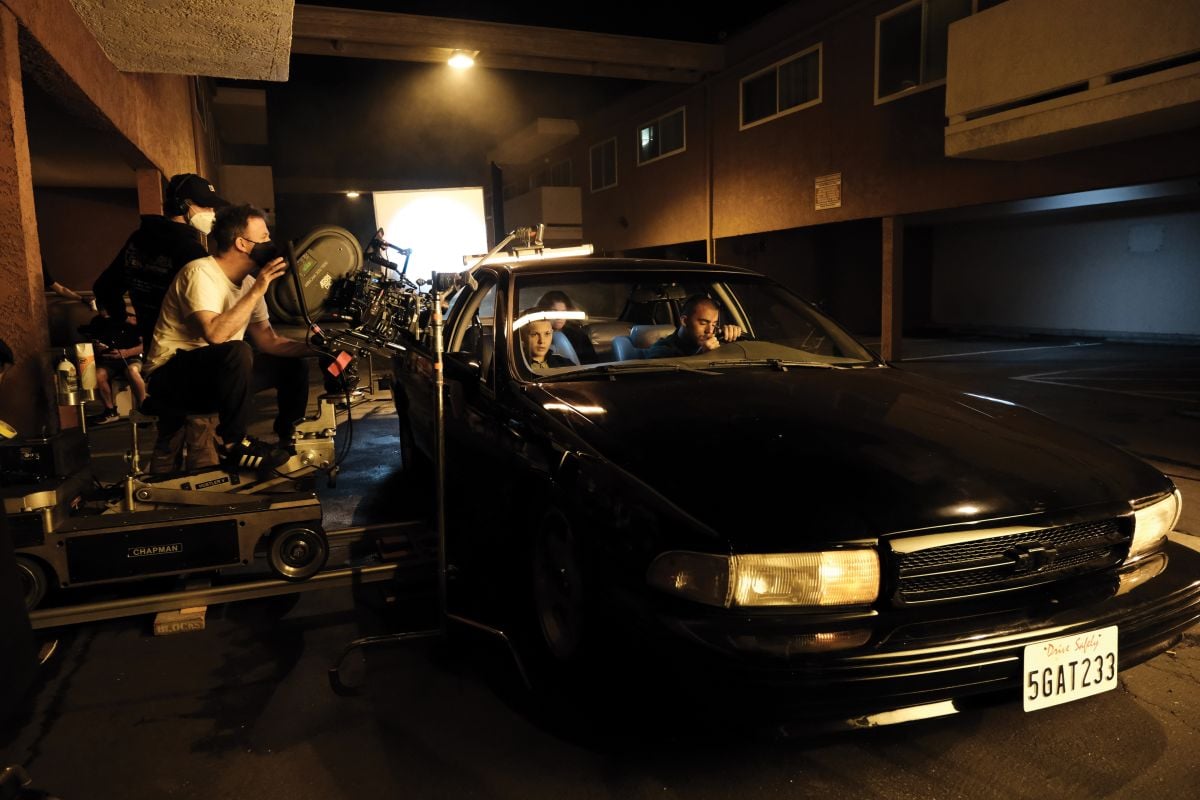
The cinematographer eventually decided that Kodak’s recently revived Ektachrome 100D 5294 film stock could help achieve a similar kind of gritty, amateur look. But he understood shooting on Ektachrome would pose issues. “The Ektachrome became a big part of our aesthetic in Season 2,” he says. “We shot around 50 percent of the season on it. I was trying to get the rest of the footage, which we shot on Kodak Vision3 500T 5219, as close to that look as possible by pushing it and trying to create contrast with our lighting. We didn’t use any Kodak 250D; we just shot the day exteriors on 500T and balanced it with filters or in the grade. I was trying to match the grain and grittiness of the Ektachrome stock, and I love the corrected skin tones we got with the 500T.”
While Vision3 500T stock provides amazing latitude and very true colors, Ektachrome 100D has significantly less latitude. Ektachrome is also a reversal stock, yet Rév had it cross-processed as a negative, which made the resulting image green. “It’s a hard stock to shoot on, I can tell you that,” he says with a laugh. “First of all, it requires a lot of light. Second, it’s very contrasty, so you have to create a softly lit or front-lit set. The lighting doesn’t look good on the monitor, or to your eye — it goes against your instincts. You just have to rely upon your light meter and your stock and trust that when the footage comes back from the lab, it will have the contrast and the colors you were going for.”
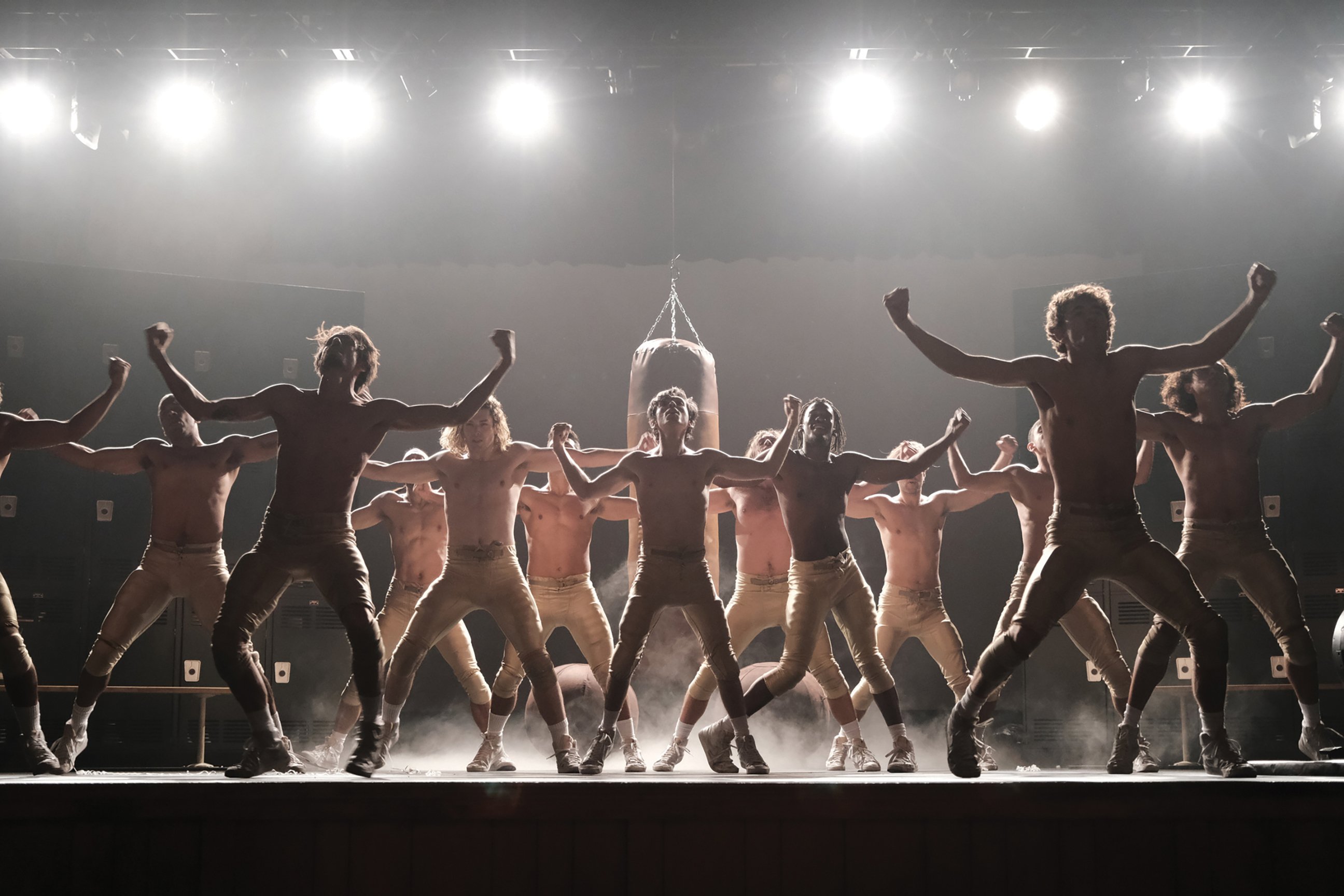
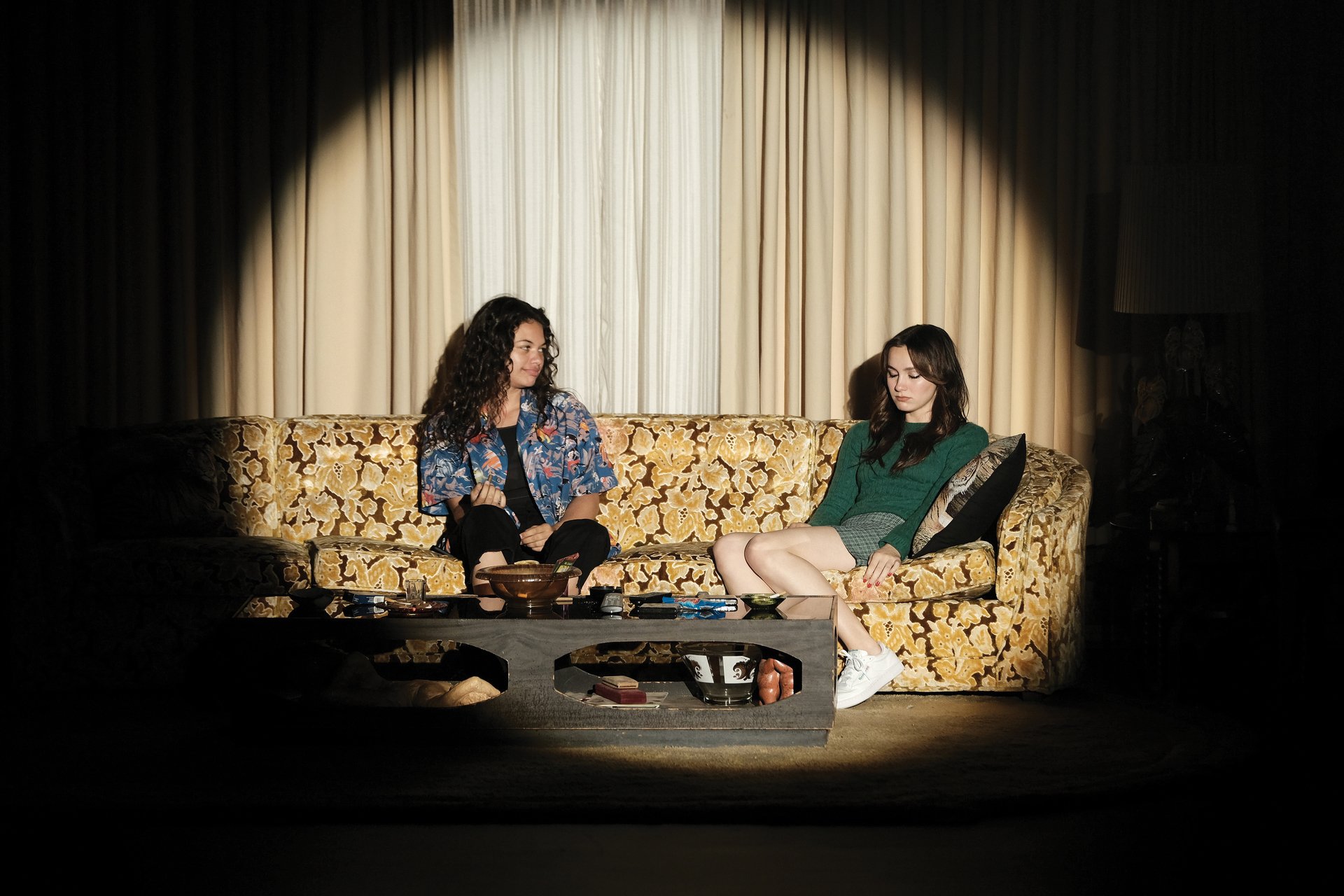
He adds: “Especially when cross-processing Ektachrome, you get these weird colors that are hard to control. You definitely need a lot of testing to figure it out.”
Rév shot the entire first episode of Season 2 on the tricky stock, including a house party at the end of the episode. Ektachrome required more than four times the light than Vision3 500 stock, so he deployed Condors equipped with both 18K HMI and 20K tungsten units or MaxiBrutes, as well as balloon lights. For close-ups, he relied on inexpensive paper lanterns. “You have to front-light faces when shooting on Ektachrome because it’s one of the only ways to make them look good,” he says. “But the diffusion and the round surface of the paper lanterns create something nice in combination with Ektachrome. The resulting light fills up the face in a way that has some slight contrast.”
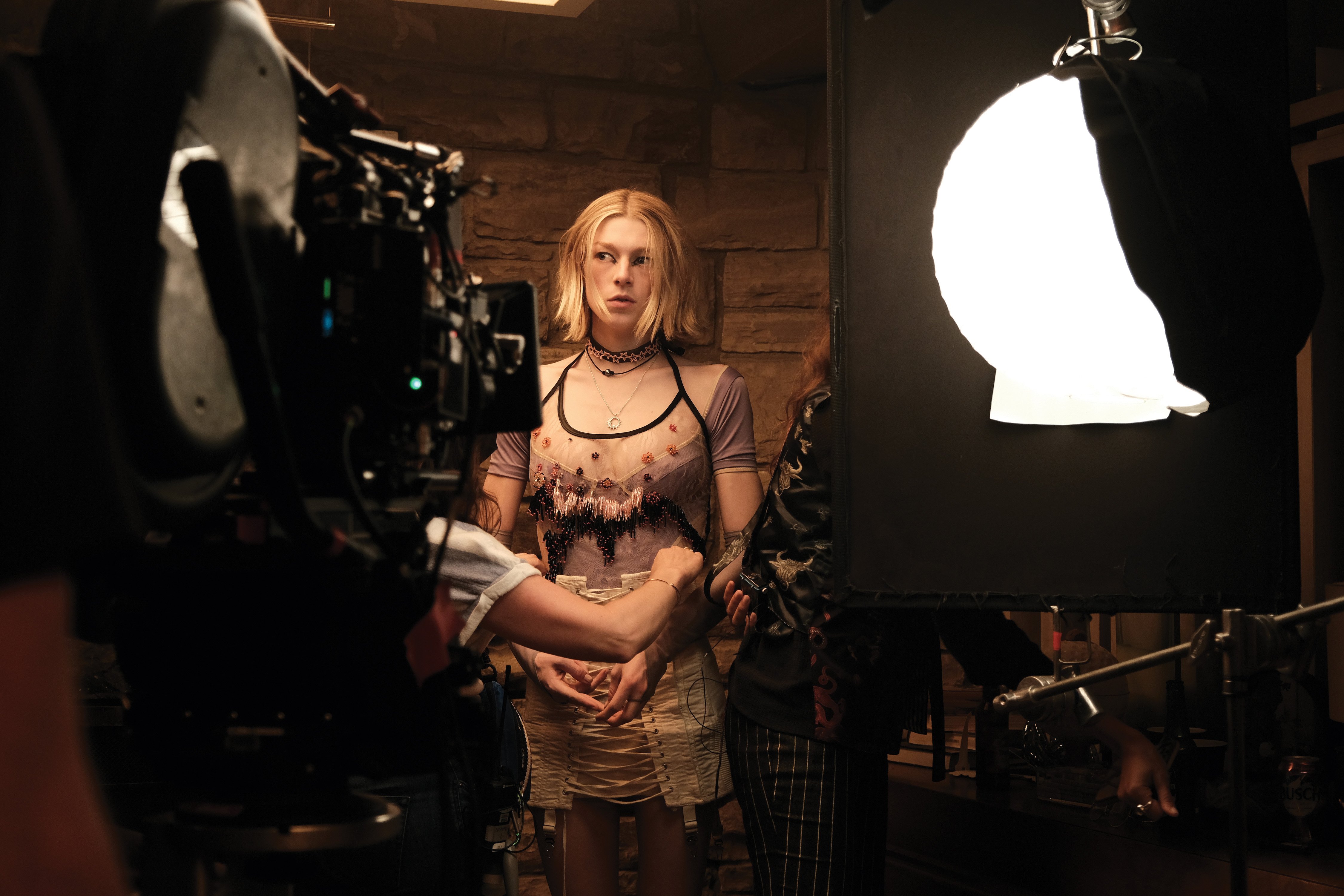
Despite the difficulties of shooting on a stock like Ektachrome, Rév relished the challenge. “When you’re shooting on film, you’re constantly trying to imagine an image in your head, which forces you to doubt yourself and keep coming up with ideas. So, the process is not done until you grade it,” he says. “On digital, nowadays you can grade on set and create something final, so you’re making your decisions there. Film has more mystery to it — and I enjoy that mystery.”
Rév subsequently participated in an ASC Clubhouse Conversations roundtable to discuss his Emmy-nominated Euphoria episode “The Theater and Its Double”:
Here he talks about the first season of the series:
Season 1
1.78:1
Cameras: Arri Alexa 65
Specials: Arricam LT, Arri 416
Lenses: Arri Rental Prime DNA
Specials: Arri/Zeiss Master Prime, Arriflex/Zeiss Super Speed, Kowa Cine Prominar, Cooke S4/i
Season 2
1.85:1
Cameras: Arri LT, Arri 435, Arri 416
Lenses: Cooke S4/i, Panchro; Arriflex/Zeiss Super Speed (“B Speed”)
Film Stocks: Kodak Vision3 500T 5219, Kodak Ektachrome 100D 5294






